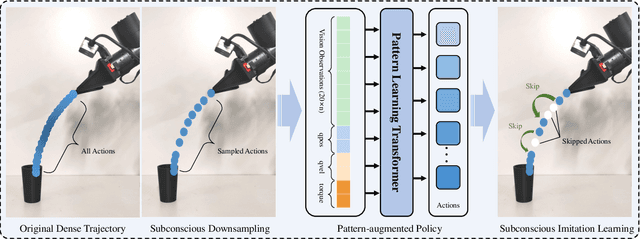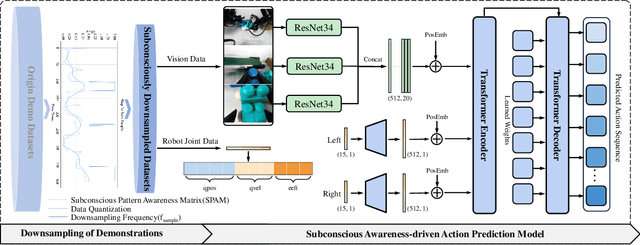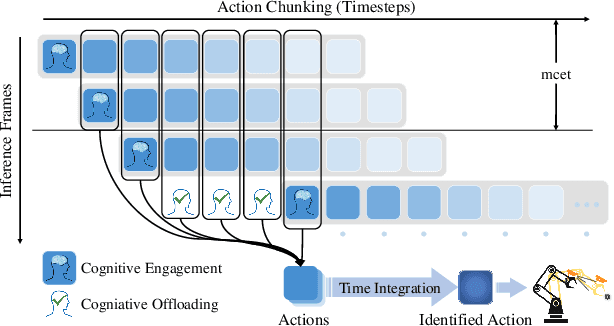Jun Xie
PCIE_Interaction Solution for Ego4D Social Interaction Challenge
May 30, 2025Abstract:This report presents our team's PCIE_Interaction solution for the Ego4D Social Interaction Challenge at CVPR 2025, addressing both Looking At Me (LAM) and Talking To Me (TTM) tasks. The challenge requires accurate detection of social interactions between subjects and the camera wearer, with LAM relying exclusively on face crop sequences and TTM combining speaker face crops with synchronized audio segments. In the LAM track, we employ face quality enhancement and ensemble methods. For the TTM task, we extend visual interaction analysis by fusing audio and visual cues, weighted by a visual quality score. Our approach achieved 0.81 and 0.71 mean average precision (mAP) on the LAM and TTM challenges leader board. Code is available at https://github.com/KanokphanL/PCIE_Ego4D_Social_Interaction
PCIE_Pose Solution for EgoExo4D Pose and Proficiency Estimation Challenge
May 30, 2025Abstract:This report introduces our team's (PCIE_EgoPose) solutions for the EgoExo4D Pose and Proficiency Estimation Challenges at CVPR2025. Focused on the intricate task of estimating 21 3D hand joints from RGB egocentric videos, which are complicated by subtle movements and frequent occlusions, we developed the Hand Pose Vision Transformer (HP-ViT+). This architecture synergizes a Vision Transformer and a CNN backbone, using weighted fusion to refine the hand pose predictions. For the EgoExo4D Body Pose Challenge, we adopted a multimodal spatio-temporal feature integration strategy to address the complexities of body pose estimation across dynamic contexts. Our methods achieved remarkable performance: 8.31 PA-MPJPE in the Hand Pose Challenge and 11.25 MPJPE in the Body Pose Challenge, securing championship titles in both competitions. We extended our pose estimation solutions to the Proficiency Estimation task, applying core technologies such as transformer-based architectures. This extension enabled us to achieve a top-1 accuracy of 0.53, a SOTA result, in the Demonstrator Proficiency Estimation competition.
Four Eyes Are Better Than Two: Harnessing the Collaborative Potential of Large Models via Differentiated Thinking and Complementary Ensembles
May 22, 2025Abstract:In this paper, we present the runner-up solution for the Ego4D EgoSchema Challenge at CVPR 2025 (Confirmed on May 20, 2025). Inspired by the success of large models, we evaluate and leverage leading accessible multimodal large models and adapt them to video understanding tasks via few-shot learning and model ensemble strategies. Specifically, diversified prompt styles and process paradigms are systematically explored and evaluated to effectively guide the attention of large models, fully unleashing their powerful generalization and adaptability abilities. Experimental results demonstrate that, with our carefully designed approach, directly utilizing an individual multimodal model already outperforms the previous state-of-the-art (SOTA) method which includes several additional processes. Besides, an additional stage is further introduced that facilitates the cooperation and ensemble of periodic results, which achieves impressive performance improvements. We hope this work serves as a valuable reference for the practical application of large models and inspires future research in the field.
Feature Matching Intervention: Leveraging Observational Data for Causal Representation Learning
Mar 05, 2025Abstract:A major challenge in causal discovery from observational data is the absence of perfect interventions, making it difficult to distinguish causal features from spurious ones. We propose an innovative approach, Feature Matching Intervention (FMI), which uses a matching procedure to mimic perfect interventions. We define causal latent graphs, extending structural causal models to latent feature space, providing a framework that connects FMI with causal graph learning. Our feature matching procedure emulates perfect interventions within these causal latent graphs. Theoretical results demonstrate that FMI exhibits strong out-of-distribution (OOD) generalizability. Experiments further highlight FMI's superior performance in effectively identifying causal features solely from observational data.
Subconscious Robotic Imitation Learning
Dec 29, 2024



Abstract:Although robotic imitation learning (RIL) is promising for embodied intelligent robots, existing RIL approaches rely on computationally intensive multi-model trajectory predictions, resulting in slow execution and limited real-time responsiveness. Instead, human beings subconscious can constantly process and store vast amounts of information from their experiences, perceptions, and learning, allowing them to fulfill complex actions such as riding a bike, without consciously thinking about each. Inspired by this phenomenon in action neurology, we introduced subconscious robotic imitation learning (SRIL), wherein cognitive offloading was combined with historical action chunkings to reduce delays caused by model inferences, thereby accelerating task execution. This process was further enhanced by subconscious downsampling and pattern augmented learning policy wherein intent-rich information was addressed with quantized sampling techniques to improve manipulation efficiency. Experimental results demonstrated that execution speeds of the SRIL were 100\% to 200\% faster over SOTA policies for comprehensive dual-arm tasks, with consistently higher success rates.
Deliberation in Latent Space via Differentiable Cache Augmentation
Dec 23, 2024



Abstract:Techniques enabling large language models (LLMs) to "think more" by generating and attending to intermediate reasoning steps have shown promise in solving complex problems. However, the standard approaches generate sequences of discrete tokens immediately before responding, and so they can incur significant latency costs and be challenging to optimize. In this work, we demonstrate that a frozen LLM can be augmented with an offline coprocessor that operates on the model's key-value (kv) cache. This coprocessor augments the cache with a set of latent embeddings designed to improve the fidelity of subsequent decoding. We train this coprocessor using the language modeling loss from the decoder on standard pretraining data, while keeping the decoder itself frozen. This approach enables the model to learn, in an end-to-end differentiable fashion, how to distill additional computation into its kv-cache. Because the decoder remains unchanged, the coprocessor can operate offline and asynchronously, and the language model can function normally if the coprocessor is unavailable or if a given cache is deemed not to require extra computation. We show experimentally that when a cache is augmented, the decoder achieves lower perplexity on numerous subsequent tokens. Furthermore, even without any task-specific training, our experiments demonstrate that cache augmentation consistently reduces perplexity and improves performance across a range of reasoning-intensive tasks.
Slender Object Scene Segmentation in Remote Sensing Image Based on Learnable Morphological Skeleton with Segment Anything Model
Nov 13, 2024



Abstract:Morphological methods play a crucial role in remote sensing image processing, due to their ability to capture and preserve small structural details. However, most of the existing deep learning models for semantic segmentation are based on the encoder-decoder architecture including U-net and Segment Anything Model (SAM), where the downsampling process tends to discard fine details. In this paper, we propose a new approach that integrates learnable morphological skeleton prior into deep neural networks using the variational method. To address the difficulty in backpropagation in neural networks caused by the non-differentiability presented in classical morphological operations, we provide a smooth representation of the morphological skeleton and design a variational segmentation model integrating morphological skeleton prior by employing operator splitting and dual methods. Then, we integrate this model into the network architecture of SAM, which is achieved by adding a token to mask decoder and modifying the final sigmoid layer, ensuring the final segmentation results preserve the skeleton structure as much as possible. Experimental results on remote sensing datasets, including buildings and roads, demonstrate that our method outperforms the original SAM on slender object segmentation and exhibits better generalization capability.
Large Language Model for Multi-Domain Translation: Benchmarking and Domain CoT Fine-tuning
Oct 03, 2024



Abstract:Achieving consistent high-quality machine translation (MT) across diverse domains remains a significant challenge, primarily due to the limited and imbalanced parallel training data available in various domains. While large language models (LLMs) have demonstrated impressive general understanding and generation abilities, their potential in multi-domain MT is under-explored. We establish a comprehensive benchmark for multi-domain translation, featuring 25 German$\Leftrightarrow$English and 22 Chinese$\Leftrightarrow$English test sets respectively covering 15 domains. Our evaluation of prominent LLMs reveals a discernible performance gap against traditional MT systems, highlighting domain overfitting and catastrophic forgetting issues after fine-tuning on domain-limited corpora. To mitigate this, we propose a domain Chain of Thought (CoT) fine-tuning technique that utilizes the intrinsic multi-domain intelligence of LLMs to improve translation performance. This method inspires the LLM to perceive domain information from the source text, which then serves as a helpful hint to guide the translation process. Despite being trained on a small dataset of four domains, our CoT fine-tune approach achieves notable enhancements in translation accuracy and domain robustness than traditional fine-tuning, as evidenced by an average 1.53 BLEU score increase in over 20 German$\rightarrow$English distinct out-of-domain tests.
Cross-Dataset Gaze Estimation by Evidential Inter-intra Fusion
Sep 07, 2024



Abstract:Achieving accurate and reliable gaze predictions in complex and diverse environments remains challenging. Fortunately, it is straightforward to access diverse gaze datasets in real-world applications. We discover that training these datasets jointly can significantly improve the generalization of gaze estimation, which is overlooked in previous works. However, due to the inherent distribution shift across different datasets, simply mixing multiple dataset decreases the performance in the original domain despite gaining better generalization abilities. To address the problem of ``cross-dataset gaze estimation'', we propose a novel Evidential Inter-intra Fusion EIF framework, for training a cross-dataset model that performs well across all source and unseen domains. Specifically, we build independent single-dataset branches for various datasets where the data space is partitioned into overlapping subspaces within each dataset for local regression, and further create a cross-dataset branch to integrate the generalizable features from single-dataset branches. Furthermore, evidential regressors based on the Normal and Inverse-Gamma (NIG) distribution are designed to additionally provide uncertainty estimation apart from predicting gaze. Building upon this foundation, our proposed framework achieves both intra-evidential fusion among multiple local regressors within each dataset and inter-evidential fusion among multiple branches by Mixture \textbfof Normal Inverse-Gamma (MoNIG distribution. Experiments demonstrate that our method consistently achieves notable improvements in both source domains and unseen domains.
RLPF: Reinforcement Learning from Prediction Feedback for User Summarization with LLMs
Sep 06, 2024



Abstract:LLM-powered personalization agent systems employ Large Language Models (LLMs) to predict users' behavior from their past activities. However, their effectiveness often hinges on the ability to effectively leverage extensive, long user historical data due to its inherent noise and length of such data. Existing pretrained LLMs may generate summaries that are concise but lack the necessary context for downstream tasks, hindering their utility in personalization systems. To address these challenges, we introduce Reinforcement Learning from Prediction Feedback (RLPF). RLPF fine-tunes LLMs to generate concise, human-readable user summaries that are optimized for downstream task performance. By maximizing the usefulness of the generated summaries, RLPF effectively distills extensive user history data while preserving essential information for downstream tasks. Our empirical evaluation demonstrates significant improvements in both extrinsic downstream task utility and intrinsic summary quality, surpassing baseline methods by up to 22% on downstream task performance and achieving an up to 84.59% win rate on Factuality, Abstractiveness, and Readability. RLPF also achieves a remarkable 74% reduction in context length while improving performance on 16 out of 19 unseen tasks and/or datasets, showcasing its generalizability. This approach offers a promising solution for enhancing LLM personalization by effectively transforming long, noisy user histories into informative and human-readable representations.
 Add to Chrome
Add to Chrome Add to Firefox
Add to Firefox Add to Edge
Add to Edge